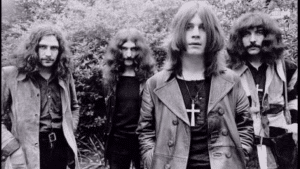Iconic Beatles Songs That Never Made It To No.1

via J K / YouTube
It may seem at first that almost all of The Beatles’ songs have reached the top of the Billboard charts. But this view, alluring as it may be, is not accurate. For any musical group, reaching that kind of global appeal and continuous success is a remarkable achievement.
With an astounding 20 chart-toppers, the Fab Four have unquestionably amassed the most No. 1 hit singles on the Billboard Hot 100, an astonishing accomplishment. This achievement was so noteworthy that the band chose to put all these classic songs together on an album they aptly called 1, which was released in 2000.
But for all the glory of their number-one hits, it’s important to understand that not all of the Beatles’ songs made it to the top of the Hot 100. Despite their unprecedented popularity, the erstwhile Mop Tops have a noteworthy archive of excellent songs that, for a variety of reasons, failed to secure the top spot.
The Beatles’ chart performance demonstrates a dualism that adds complexity to their story by demonstrating that, even with their great popularity, there were times when their domination was not unchallenged. The following eight iconic Beatles songs are just some of the great ones that didn’t reach the top spot for one reason or another.
“Eleanor Rigby” (1966)
This song, which was first heard on the Beatles’ 1966 album Revolver, is a classic that explores themes of loneliness and highlights Paul McCartney’s skill with a wide range of instruments and rich vocal harmonies. The song was particularly successful because it peaked at No. 11 on the Billboard Hot 100 rankings.
“Eleanor Rigby” marks a turning point in the Fab Four’s career, as they went from being primarily a rock and roll and pop group to one that welcomed studio experimentation. George Martin’s unique double-string quartet arrangement sets the song apart, and its lyrics give the song a narrative quality.
This musical arrangement and lyrical content deviation from traditional popular music rules is evidence of the Beatles’ continuous exploration of new creative horizons.
“Strawberry Fields Forever” (1967)
Released in 1967 as a stand-alone single along with its Double-A side “Penny Lane”, this hallucinogenic song by John Lennon peaked at No. 8 on the Billboard Hot 100. The song is still regarded as one of the band’s most bizarre and recognizable songs.
“Strawberry Fields Forever” was the Beatles’ first recording after Revolver was finished, and it was originally intended to go on their next album, Sgt. Pepper’s Lonely Hearts Club Band, which had no title yet at the time.
But the band reluctantly released it as a single, sticking to their policy of not including previously released singles from albums, because their management and record label insisted on new material. John Lennon considered “Strawberry Fields Forever” his best song with the Beatles, even in spite of the circumstances.
“Here Comes the Sun” (1969)
This song, which can be found on the Beatles’ 1969 album Abbey Road, was written by lead guitarist George Harrison when he was staying at Eric Clapton’s house for some time and wanted to be away from his fellow Fab Four members.
This moment of seeking solace was one in a sequence of happenings that announced the band’s impending dissolution as the decade came to a conclusion. The Quite Beatle, full of hope for the future, wrote a song that welcomed the approaching light. It reached its greatest position on the Billboard Hot 100 (Recurrents) at No. 2 in 2010.
Music critics have given “Here Comes the Sun” high marks, bringing George’s songwriter status up to that of his bandmates, John Lennon and Paul McCartney, especially when paired with his other iconic Abbey Road contribution, “Something”.
“While My Guitar Gently Weeps” (1968)
Another one of George Harrison’s compositions, this one was included on The Beatles’ 1968 self-titled double album, fondly known as The White Album. In a song where Clapton does not receive credit for his lead guitar, the song explores themes of worldly misery and the seeming inability of regular people to address such problems.
What’s amazing is that this classic Beatles song has not charted on the Billboard Hot 100 list. Harrison recorded the song’s original version using just an acoustic guitar and harmonium with minimal backing. This version first appeared on the Anthology 3 outtakes compilation in 1996.
Harrison and Clapton worked together on several recordings in the late 1960s, including this one. The two went on to co-write “Badge” for Clapton’s band Cream after finishing this assignment.
“Yellow Submarine” (1966)
Ringo Starr’s lyrical soothing vocals famously starred in this song, which was first featured on Revolver. It’s interesting to note that, although being written as a children’s song by McCartney and Lennon, the song came dangerously close to becoming the number one hit in the United States, peaking at No. 2 on the Billboard Hot 100.
The Beatles recorded “Yellow Submarine” in late May 1966, at a period characterized by studio experimentation. The first version included the basic track and vocals. The band then recorded a session to add overdubs, which included chorus singing, party vibes, and nautical sound effects.
The track had an impact that went beyond the music. The 1968 animated picture of the same name drew inspiration from it, and the song was aptly positioned as the first track on the official soundtrack album.
“With a Little Help from My Friends” (1967)
This song, which was featured as the second track on the Beatles’ 1967 album Sgt. Pepper’s Lonely Hearts Club Band, became even more well-known because of its notable performance by, again, the doe-eyed Ringo.
The song has gained popularity since the Fab Four released it thanks to a number of notable cover versions, the most well-known of which is Joe Cocker’s. It’s interesting to note that Cocker’s rendition topped the UK charts. only made it to No. 68 on the Billboard Hot 100 singles chart. The original version of the song by The Beatles never reached the charts.
Lennon and McCartney finished writing the song in the middle of March 1967, with the intention of using it as Starr’s spot in the album. As McCartney put it, “It was pretty much co-written, John and I doing a work song for Ringo, a little craft job.”
“Sgt. Pepper’s Lonely Hearts Club Band” (1967)
It makes sense that this song, which can be found on The Fab Four’s album of the same name, would never reach the top of the charts given its unique title and instantly identifiable sound.
This absence might be explained by the song’s role as an introduction to the concept album rather than a stand-alone single. Still, the lead single peaked at No. 71 on the Billboard Hot 100.
Although the song is officially credited to Lennon–McCartney, John Lennon stated that McCartney was the original inspiration for “Sgt. Pepper”. The Beatles recorded the song in Abbey Road’s Studio 2, with George Martin producing and Geoff Emerick handling the engineering. The song was worked on for three further sessions, starting on February 1st, 1967, and ending on March 6th, 1967.
“In My Life” (1965)
This Lennon song, which was included in the Beatles’ 1965 album Rubber Soul, is frequently considered to be his most autobiographical work as it was dubbed by Lennon himself as his “first real major piece of work”. Amazingly, this eerie yet lovely song peaked at No. 9 on the Billboard Hot 100 Recurrents chart in 2010.
This song, credited to the songwriting team of Lennon and McCartney, is notable for being one of the few with contested main authorship. Lennon wrote the words, but he and McCartney later disagreed over where the melody came from. Martin is credited with writing the piano solo bridge.
“In My Life” was named the greatest song of all time by Mojo in 2000. On their 2004 list of “The 500 Greatest Songs of All Time”, Rolling Stone placed it as the 23rd greatest song. On their updated 2021 list, they ranked it at number 98.



















